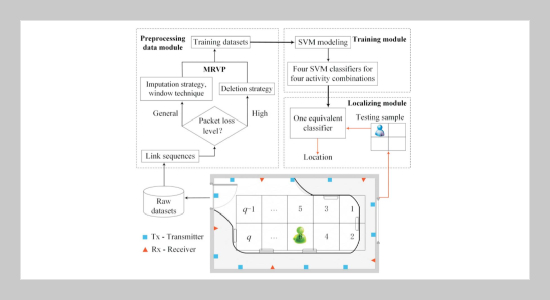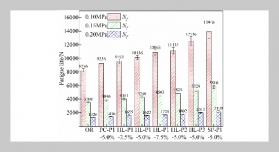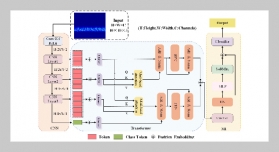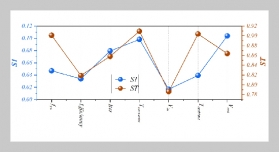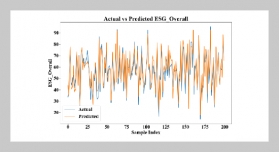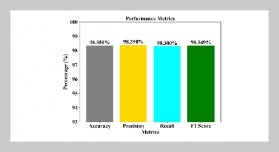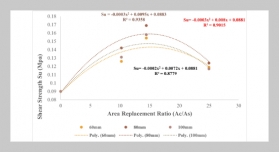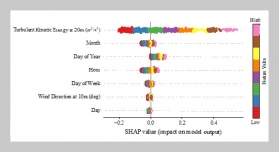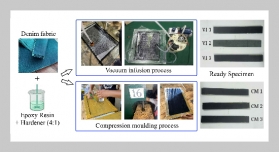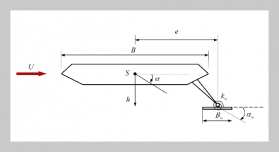Jinjun Liu1, Shenghui Zhao This email address is being protected from spambots. You need JavaScript enabled to view it.1, Zhihong Xu1 and Guilin Chen1 1School of Computer and Information Engineering, Chuzhou University, Chuzhou City, Anhui Province 239000, P.R. China
Received:
February 22, 2017
Accepted:
May 3, 2017
Publication Date:
September 1, 2017
Download Citation:
||https://doi.org/10.6180/jase.2017.20.3.12
The device-free passive localization has been received much attention in the past few years. An important issue with this technique is that the packet containing the received signal strength readings may be lost and negatively affects the localization accuracy. To address the challenge of packet loss, we propose a fingerprint-based packet-loss resistant method that combines a missing RSS value processing algorithm with a support vector machine model. To evaluate the proposed method, comprehensive experiments are conducted in various settings in which the maximum packet loss rates of links reach 22.63% and samples reach 28.80%. The proposed method outperforms previously proposed linear discriminant analysis and Naive Bayes algorithms, achieving localization accuracies at least 94.86% in an empty room and 93.32% in a cluttered room. Further simulations show that the proposed method works well even for extreme conditions when approximately 50% of original samples are discarded. The experiment results also reveal that the proposed method is insensitive to different human activities including standing and walking, thus reduces training cost.ABSTRACT
Keywords:
Device-free Passive Localization, Packet Loss, Wireless Sensor Networks, Support Vector Machine
[1] Wang, J., Gao, Q., Wang, H., Cheng, P. and Xin, K., “Device-free Localization with Multidimensional Wireless Link Information,” IEEE Transactions on Vehicular Technology, Vol. 64, No. 1, pp. 356366 (2015). doi: 10.1109/TVT.2014.2318084 [2] Hung, C. F., Tuan, C. C. and Jhuang, F. M., “Improving Wi-Fi Indoor-positioning Accuracy by Using AP Selection and Adaptive Pattern Matching,” Journal of Applied Science and Engineering, Vol. 19, No. 3, pp. 337346 (2016). doi: 10.6180/jase.2016.19.3.12 [3] Youssef, M., Mah, M. and Agrawala, A., “Challenges Device-free Passive Localization for Wireless Environments,” Proc. of the 13th Annual ACM International Conference on Mobile Computing and Networking, pp. 222–229 (2007). doi: 10.1145/1287853. 1287880 [4] Xu, C., Firner, B., Zhang, Y., Howard, R., Li, J. and Lin, X., “Improving rf-based Device-free Passive Localization in Cluttered Indoor Environments through Probabilistic Classification Methods,” Proc. of the 2012 ACM/IEEE International Conference on Information Processing in Sensor Networks, pp. 209–220 (2012). doi: 10.1109/IPSN.2012.6920958 [5] Zhang, D., Ma, J., Chen, Q. and Ni, L. M., “An rfbased System for Tracking Transceiver-free Objects,” Proc. of the fifth Annual IEEE International Conference on Pervasive Computing and Communications, pp. 135–144 (2007). doi: 10.1109/PERCOM.2007.8 [6] Wilson, J. and Patwari, N., “Radio Tomographic Imaging with Wireless Networks,” IEEE Transactions on Mobile Computing, Vol. 9, No. 5, pp. 621–632 (2010). doi: 10.1109/TMC.2009.174 [7] Kong, L., Xia, M., Liu, X. Y., Wu, M. Y. and Liu, X., “Data Loss and Reconstruction in Sensor Networks,” Proc. of IEEE INFOCOM, pp. 1654–1662 (2013). doi: 10.1109/INFCOM.2013.6566962 [8] Kaltiokallio, O., Bocca, M. and Patwari, N., “Enhancing the Accuracy of Radio Tomographic Imaging Using Channel Diversity,” Proc. of the 9th International Conference on Mobile Adhoc and Sensor Systems, pp. 254–262 (2012). doi: 10.1109/MASS.2012.6502524 [9] Xu, C., Firner, B., Zhang, Y., Howard, R. and Li, J., “Poster: Statistical Learning Strategies for rf-based Indoor Device-free Passive Localization,” Proc. of the 9th ACM Conference on Embedded Networked Sensor Systems, pp. 365–366 (2011). doi: 10.1145/ 2070942.2070992 [10] Hong, J. and Ohtsuki, T., “Ambient Intelligence Sensing Using Array Sensor: Device-free Radio Based Approach,” Proc. of the 2013 ACM Conference on Pervasive and Ubiquitous Computing Adjunct Publication, pp. 509–520 (2013). doi: 10.1145/2494091.2497609 [11] Zhang, D., Liu, Y., Guo, X. and Ni, L. M., “Rass: a Real-time, Accurate, and Scalable System for Tracking Transceiver-free Objects,” IEEE Transactions on Parallel and Distributed Systems, Vol. 24, No. 5, pp. 9961008 (2013). doi: 10.1109/TPDS.2012.134 [12] Hong, J. and Ohtsuki, T., “Signal Eigenvector-based Device-free Passive Localization Using Array Sensor,” IEEE Transactions on Vehicular Technology, Vol. 64, No. 4, pp. 1354–1363 (2015). doi: 10.1109/ TVT.2015.2397436 [13] Belousov, A. I., Verzakov, S. A. and Von Frese, J., “A Flexible Classification Approach with Optimal Generalisation Performance Support Vector Machines,” Chemometrics and Intelligent Laboratory Systems, Vol. 64, No. 1, pp. 15–25 (2002). doi: 10.1016/S0169-7439 (02)00046-1 [14] Woyach, K., Puccinelli, D. and Haenggi, M., “Sensorless Sensing in Wireless Networks Implementation and Measurements,” Proc. of the 4th International Symposium on Modeling and Optimization in Mobile, Ad Hoc and Wireless Networks, pp. 1–8 (2006). doi: 10.1109/WIOPT.2006.1666495 [15] Kosba, A. E., Saeed, A. and Youssef, M., “Robust Wlan Device-free Passive Motion Detection,” Proc. of the Wireless Communications and Networking Conference, pp. 3284–3289 (2012). doi: 10.1109/WCNC. 2012.6214375 [16] Moussa, M. and Youssef, M., “Smart Devices for Smart Environments Device-free Passive Detection in Real Environments,” Proc. of the IEEE International Conference on Pervasive Computing and Communications, pp. 1–6 (2009). doi: 10.1109/PERCOM.2009. 4912826 [17] Seifeldin, M., Saeed, A., Kosba, A. E., El-Keyi, A. and Youssef, M., “Nuzzer: a Large-scale Device-free Passive Localization System for Wireless Environments,” IEEE Transactions on Mobile Computing, Vol. 12, No. 7, pp. 1321–1334 (2013). doi: 10.1109/TMC.2012. 106 [18] Saeed, A., Kosba, A. E. and Youssef, M., “Ichnaea a Low-overhead Robust Wlan Device-free Passive Localization System,” IEEE Journal of Selected Topics in Signal Processing, Vol. 8, No. 1, pp. 5–15 (2014). doi: 10.1109/JSTSP.2013.2287480 [19] Xu, C., Firner, B., Moore, R. S., Zhang, Y., Trappe, W., Howard, R., Zhang, F. and An, N., “Indoor Devicefree Multi-subject Counting and Localization Using Radio Signal Strength,” Proc. of the 2013 ACM/IEEE International Conference on Information Processing in Sensor Networks, pp. 79–90 (2013). doi: 10.1109/ IPSN.2013.6917577 [20] Patwari, N. and Wilson, J., “Spatial Models for Human Motion-induced Signal Strength Variance on Static Links,” IEEE Transactions on Information Forensics and Security, Vol. 6, No. 3, pp. 791–802 (2011). doi: 10.1109/TIFS.2011.2146774 [21] Martin, R. K., Folkerts, A. and Heinl, T., “Accuracy vs. Resolution in Radio Tomography,” IEEE Transactions on Signal Processing, Vol. 62, No. 10, pp. 2480– 2491 (2014). doi: 10.1109/TSP.2014.2311969 [22] Chang, C. C. and Lin, C. J., LIBSVM a Library for Support Vector Machines (2001). Software available at http://www.csie.ntu.edu.tw/cjlin/libsvm. [23] Firner, B., Xu, C., Howard, R. and Zhang, Y., “Multiple Receiver Strategies for Minimizing Packet Loss in Dense Sensor Networks,” Proc. of the Eleventh ACM International Symposium on Mobile Ad Hoc Networking and Computing, pp. 211–220 (2010). doi: 10.1145/1860093.1860122REFERENCES


